Audi E-Tron vs Jaguar I-Pace vs Mercedes-Benz EQC comparison
As we spear headlong into electric motoring, we bring together the three big luxury crossovers on sale in India to better understand what we have in store.
Published on Oct 02, 2021 09:00:00 AM
43,343 Views
Follow us on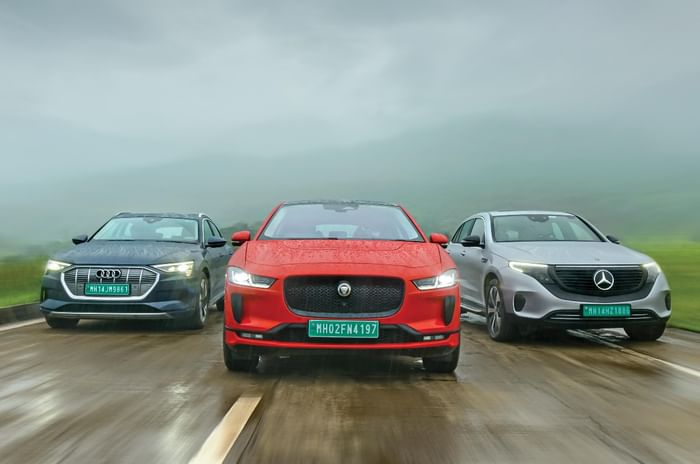
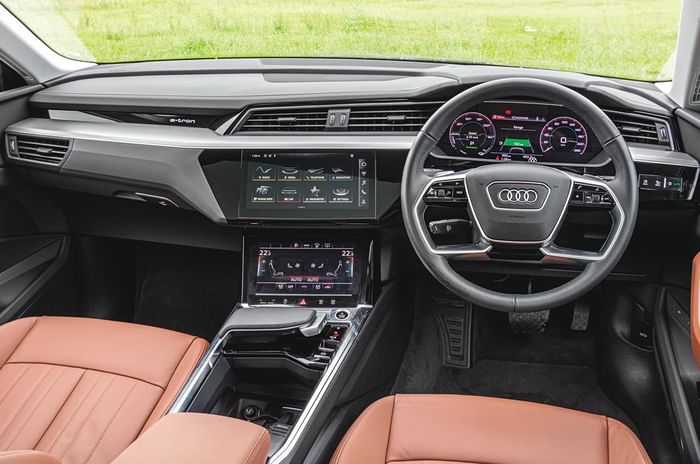
e-tron interior is practical and high on quality, but not as radical as the others.
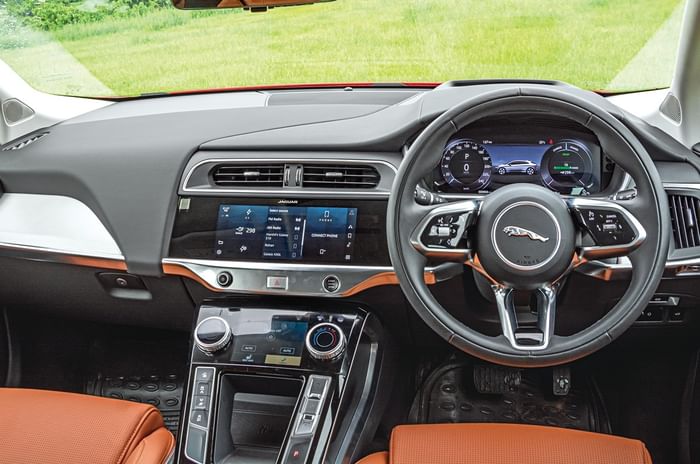
Dramatic dash and sportscar-like driving position in I-Pace.
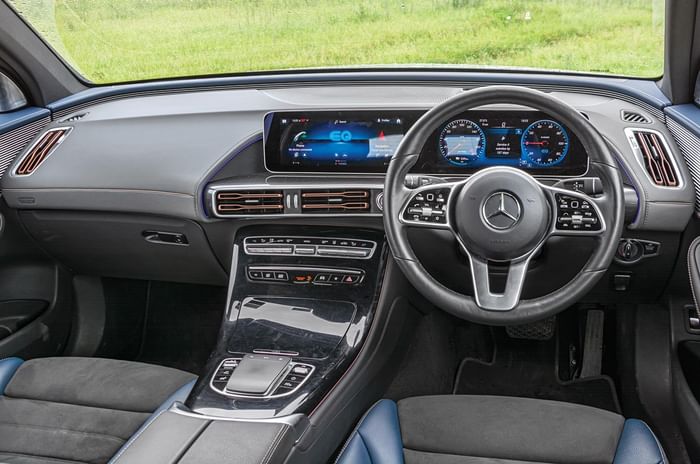
GLC interior updated with several futuristic touches for EQC.
Electric vehicles are fast becoming a reality here in India, and though the charging infrastructure has some catching up to do, the new model launches are coming fast and thick. We’ve already covered three mass-market models extensively – the Tata Nexon, Hyundai Kona Electric and MG ZS EV, but now it’s time to see what things are like at the upper end of the spectrum. They all cost in excess of a crore, but what you get are far greater shows of power, battery capacity, range and technology, and they all happen to be SUVs from established luxury car makers. We’ve driven them all individually, but now it’s time to tell you how they compare to one another. Of course, we’ll be considering the usual things – stuff like space, comfort, features, luxury and driving dynamics – but because they’re electric, there’s another dimension. We’ll also try and see which holds its charge better and ultimately gives you the longer real-world driving range, and to do that, we’re going on a long drive that includes a variety of different conditions. It’s a brave new world of luxury motoring, so come along for the ride.
Filling The Ranks
Though they operate in the same space, these three luxury electric SUVs are quite different from one another. Mercedes-Benz drew first blood, making its EQC the first luxury EV to be sold in India in October 2020. It’s based on the GLC, and that’s plain to see in its similar proportions and upright, SUV-like stance. Mercedes’ EQ design language, however, does a good job of making it look more than just a derivative, with a signature front highlighted by new LED headlamps joined by a light bar, and the EQ grille. The rear, too, has an LED light bar joining its slim tail-lamps, and the window line that ends in a sharp point lends the car greater visual length. This, and Mercedes’ bold use of 20-inch alloy wheels, makes the car appear larger than it is; until you see it alongside the other two and realise it’s half a size down.
Unlike the Mercedes, the Jaguar I-Pace bears little resemblance to any of its stablemates; in fact, it looks like nothing else on sale right now. Its low-slung, cab-forward shape is miles away from the traditional SUV form, but it just has such a futuristic appeal that’s sure to be a draw all on its own. The radically raked front and rear windshields, the latter is so acute that Jaguar says it doesn’t require a wiper, look like they’ve come from a supercar, but grafted onto a high-sided body with ample ground clearance. It’s not without some signature Jag elements, however, like the big grille, slim headlamps with the ‘J Blade’ DRLs and familiar slim LED tail-lamps. It may be the oldest of this lot, but its look is by far the most forward reaching.
| Jaguar F-Pace Price, Mileage, Specifications, Features and Variants | |
|---|---|
| Brand | Jaguar |
| Model Name | F-Pace |
| Jaguar F-Pace Price | ₹ 89.56 lakh |
| Jaguar F-Pace Range/Mileage | NA |
| Jaguar F-Pace Specifications | SUV | 5 doors | 5 seats View All Specs |
| Jaguar F-Pace Features | LED headlight | 10-inch Touchscreen display | 6 airbags View All Features |
| Jaguar F-Pace Variants | 2.0 Petrol R-Dynamic S View All Variants |
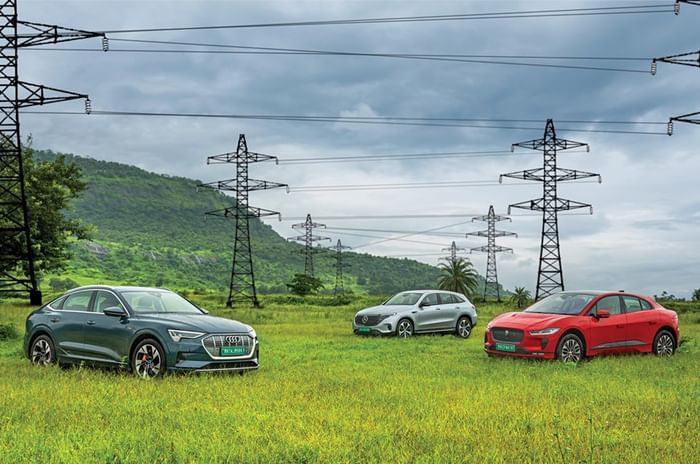
The Audi e-tron, uniquely, is available in two body styles, and while the standard version offers more practicality, it’s this Sportback coupe-SUV version that adds some visual pizzazz, which we think buyers will want from their luxury EV. Up front, it’s pretty standard Audi SUV fare, but it’s the sloping roof that ends in a duck-tail spoiler that really gets your attention. The orange brake calipers inside the smart 20-inch wheels are a nice, subtle link to its EV powertrain, and seen alongside the others, this is plainly the largest of the trio.
Let’s Talk Numbers
Though the idea of an EV may sound hugely advanced and new-fangled, the mechanicals are actually very simple. Each of these cars has two electric motors, one at each axle, with a battery pack nestled between them under the floor. Electricity goes from the battery to the permanent magnet synchronous motors, which in turn spin the wheels, and that’s it – no cylinders, fuel, combustion, compression ratio, intake, exhaust, turbos or even gears. But where things start getting really cool in these luxury EVs is their ability to split torque infinitely and near-instantaneously to each wheel, allowing for not just all-wheel drive, but also torque vectoring. That’s the advantage of fewer moving parts.
Where these cars differ is in their battery capacities, and maximum power and torque outputs. The Mercedes has the smallest battery, at 80kWh, but has the highest torque output – an AMG-rivalling 760Nm! Conversely, the Audi has the least torque – 664Nm – but the largest battery capacity – 95kWh, and the Jaguar is in the middle with 90kWh and 696Nm. On power, they’re evenly matched, the I-Pace putting out a maximum of 400hp, with the other two making 408hp each. One thing’s for sure, those are all numbers much higher than we’re used to from the average petrol or diesel luxury SUV.
The thing is, with their heavy battery packs, each of these weighs about 20 percent more than a similarly sized combustion-engine luxury SUV, which should tip the scales back, right? Well, not quite, and that’s because all that torque is available from ‘0rpm’ in an EV, so there is absolutely no delay in response.
The Jag (incidentally the lightest by far, at 2.2 tonnes, helped by its all-aluminium construction) clocks in the quickest time to 100kph – 4.97sec – and is also the quickest in rolling acceleration, which is in keeping with its sporting intent. Being the heaviest and with the least torque, it’s no surprise the Audi is the slowest, but then again 5.8sec to 100kph is hardly shabby. A little bit ahead is the Merc with a 5.5sec 0-100kph time, but what’s interesting is that, after this point, acceleration simply drops off a cliff, as the EQC rapidly falls behind the other two. Still, it does perform admirably in rolling acceleration.
| Specifications | |||
|---|---|---|---|
| Audi e-tron Sportback 55 Quattro | Jaguar I-Pace EV400 HSE | Mercedes-Benz EQC 400 | |
| L/W/H | 5014/1976/1673mm | 4682/2011/1566mm | 4762/1884/1624mm |
| Wheelbase | 2928mm | 2990mm | 2873mm |
| Boot capacity | 616 litres | 505 litres | 500 litres |
| Battery capacity | 95kWh | 90kWh | 80kWh |
| Power | 300kW (408hp) | 294kW (400hp) | 300kW (408hp) |
| Torque | 664Nm | 696Nm | 760Nm |
| Kerb weight | 2595kg | 2208kg | 2495kg |
| WLTP range (claimed) | 484km | 470km | 414km |
| Real-world range (est) | 375km | 447km | 259km |
| Max charge rate (AC) | 11kW (22kW opt) | 7.4kW | 7.4kW |
| Max charge rate (DC) | 150kW | 100kW | 110kW |
| ACCELERATION FROM REST | |||
| Kph | Sec | Sec | Sec |
| 20kph | 0.99 | 0.81 | 0.93 |
| 40kph | 2.06 | 1.72 | 1.81 |
| 60kph | 3.17 | 2.63 | 2.70 |
| 80kph | 4.32 | 3.62 | 3.87 |
| 100kph | 5.81 | 4.97 | 5.55 |
| 120kph | 7.71 | 6.81 | 7.93 |
| 140kph | 10.41 | 9.20 | 11.32 |
| 160kph | 14.01 | 12.48 | 16.13 |
| ROLLING ACCELERATION | |||
| 20-80kph | 3.30 | 2.84 | 2.88 |
| 40-100kph | 3.72 | 3.27 | 3.68 |
Also interesting is that the Mercedes has two distinct levels to its throttle, which are felt prominently in Eco and Comfort modes; less so in Sport. At first the pedal feels light and the car moves forward gently and smoothly. But when it feels like you’ve reached the end of the pedal’s travel, push past a bit of resistance, and it goes down further to unlock full acceleration. This two-step process takes some getting used to and can be annoying when you just want to get a move on quickly and smoothly.
The other two feel more consistent in their power delivery, and also have distinct characters. The e-tron makes no bones about its desire to ease you into the EV driving experience. Sure, it’s quick, but even with everything set to Dynamic, the acceleration always feels manageable and never neck-snapping. It too varies the motors’ response based on the aggression of your throttle input, but unlike the EQC, there’s no noticeable step when this happens and it feels a lot more organic.
The Jaguar is a completely different animal. The acceleration is almost perfectly synced to the position of the throttle pedal, and doesn’t variate based on lighter or harder inputs; frankly, this allows for the kind of predictability and consistency you expect from an EV. You want to move forward gently, press the accelerator just a little; you want to rocket off the blocks, push down all the way – it’s as simple as that! And as the numbers show, boy, can this thing move!
You’ll also like that the Mercedes has a proper ‘creep’ function built into it, so that when you lift off the brake pedal from a standstill, it will start to move forward on its own. That sounds pretty elementary for any modern automatic car, but it’s something that needs to be built into an EV specially. The Jaguar claims to have the function, but it’s ‘unlocked’ by a light tap on the accelerator before it starts rolling. The Audi, meanwhile, does not have a creep function at all.
The Real Numbers Game
The figures that are arguably more significant than performance in EVs, especially in these early days where people are reluctant to make the switch, are those pertaining to range and power consumption. While the relative simplicity of their powertrains might suggest an equally straightforward and proportionate consumption of power, our 210km road trip showed that it was anything but. Just as we would start our fuel-efficiency tests with a full tank of petrol or diesel, all the cars began with 100 percent charge, and to eliminate variances in driving style, we rotated drivers every 40km. The drive took us through city traffic, wider, faster-flowing highways and even a bit of uphill driving on a ghat section – the true enemy of range. To give you an example of this, in the EQC, going uphill, we lost an indicated 21km of range while having driven only 3.4km. You can recoup some of this on the way back down using the regen function, but the amount is miniscule and your descent will be slow.
With the smallest battery, the highest torque output and nearly the greatest weight, you’d expect that the EQC would have the shortest driving range, but in practice it’s more than just that. The Merc chews through its battery reserves at a far higher rate than the other two, and this is illustrated by its consumption rate of between 3.5 and 4.0 km/kWh (this is the new kilometres per litre, so get used to hearing it). The other two cars averaged above 4.5km/kWh and, in fact, got close to 5 at certain points in the drive. After our drive, the EQC was left with just 19 percent of its charge and 70km of indicated range!
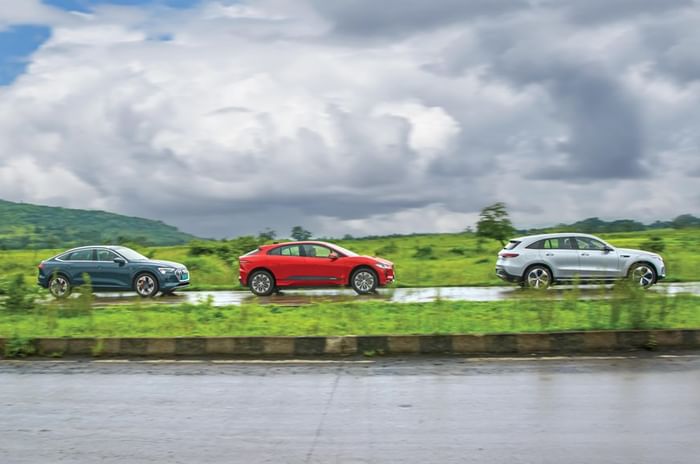
Again, for the car with the strongest performance and greatest propensity for being driven quickly, you’d expect the I-Pace to perform dismally in a range test, but it was actually the opposite. Despite not having the largest battery, the Jag’s ability to hold its charge better meant it finished the journey with 53 percent of charge and 222km of remaining range showing on its screen – a truly impressive achievement.
The e-tron is not too far behind, ending its run with 44 percent of charge and 167km of driving range remaining, and from these numbers we can extrapolate an average real-world range of 375km on a full charge. The I-Pace, in our conditions, should do a far better 447km on a full charge, and the EQC should manage around 259km.
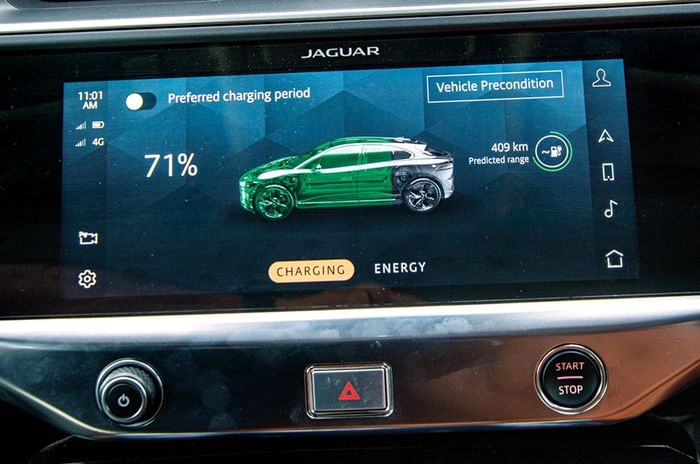
I-Pace has longest range; comprehensive data display.
Incidentally, keeping track of these numbers while driving is easiest in the I-Pace, which gives you clear readouts on the touchscreen and instrument cluster about how much power is being consumed, the battery’s state of charge, how much range you have left and where the power is being sent. The EQC, too, offers up a lot of data, but you do need to flick between a few menus to get at all of it. The e-tron, meanwhile, does serve up some information, but not as much as the others, and it’s split up between the two screens and a few menus – we wish it was a little more comprehensive and better presented.
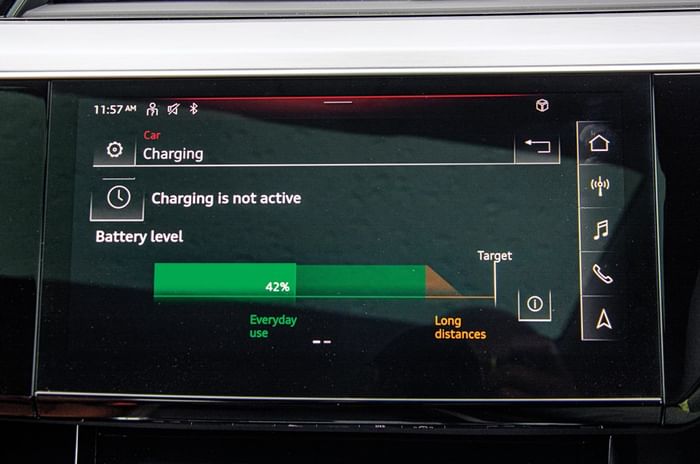
e-tron charge state and consumption data too basic.
On to the subject of charging, all these cars can be charged from a standard 15A wall socket, which takes the best part of a day for a full top-up. This, of course, is meant for when you’re in a pinch, and in reality, you’ll be relying on the AC wall-box charger installed at your home or office that each car comes with. Mercedes and Jaguar give you 7.4kW AC wall-box chargers that are claimed to get the EQC from 10-100 percent in 11 hours, and the I-Pace with its larger battery, in around 12 hours (curiously, the Jag offers an 11kW charger overseas). The e-tron, by default, charges at 11kW on its AC wall box charger, but can be ordered from the factory with 22kW charging capability too, the former capable of charging from 10-100 percent in about 8 hours, which drops to “under 5 hours” with the latter.
All three cars will charge a lot faster plugged into DC fast chargers, which each brand provides at select dealerships, and the Jag, Merc and Audi are capable of 100, 110 and 150kW DC charging rates respectively, should our public charging infrastructure ever reach these levels.
It doesn’t amount to much but, when you’re out on the road, you can recuperate a small amount of charge by regeneration via deceleration. Hitting the brakes, of course, feeds the maximum energy back into the batteries, but even just lifting off the throttle can net you a bit. All three cars let you set different levels of regen, and in the EQC and e-tron, this is done via pulling on the steering mounted paddles (in the I-Pace, you have to use the touchscreen).
The regeneration is the strongest in the EQC, so much that, at its maximum setting, you have to recalibrate your driving style to suit. It can bring the car almost to a complete halt, meaning you never really have to use the brake pedal, and so heavy is the deceleration in this mode, the brake lights come on as a safety measure. This happens in the Jaguar too, which also serves up pretty strong regen, whereas the Audi, even in its highest setting doesn’t slow you down too much.
Hushed And Plush
So that’s propulsion and recharging complete, but for luxury car buyers, comfort is crucial, and again, there’s a big difference. The EQC uses steel springs and is set up quite softly for the comfiest possible ride, and to its credit, it is genuinely plush in a way you’d expect of a Mercedes. Yes, there’s a bit of pitter-patter from the big 20-inch wheels as they roll over rough surfaces, but other than that, it’s a smooth, magic-carpet ride. But there’s an unexpected concern with the EQC and that’s its ground clearance, which thanks to a low-hanging battery pack, is less than what you get in some sports sedans! Combine that with the soft suspension that will quickly compress under braking, and you’ll find yourself crawling carefully over even medium-size speed breakers; not what you’d expect from an SUV.
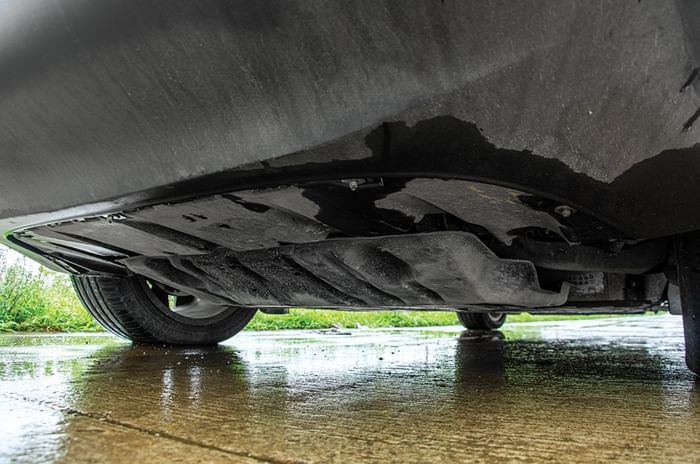
Merc’s low battery pack seriously hurts clearance.
The e-tron gets adaptive air suspension as standard, which of course offers variable ride height. It changes with the drive modes and can also be raised or lowered independently, but the good news is that even in its regular ‘Comfort’ setting, ground clearance is more than enough for even large speed breakers. It’s super comfortable in any of its modes, though perhaps not quite as plush as the Mercedes, but it makes up for it with taller tyre sidewalls for its 20-inch wheels that do a better job of soaking up rough edges.
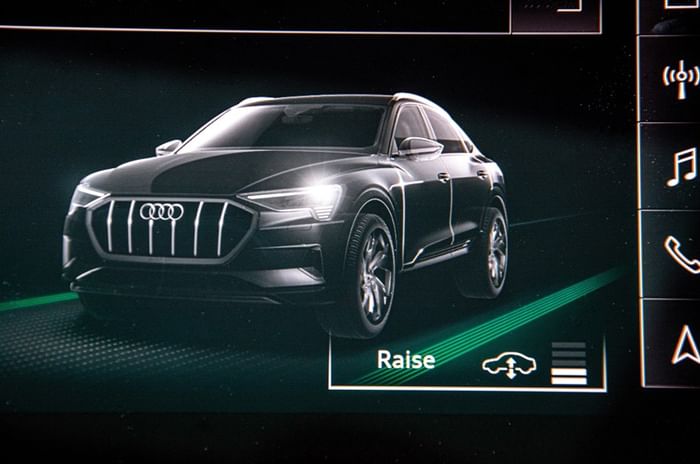
Standard air springs let you raise Audi’s ride height.
In an unprecedented move for the Indian market, Jaguar offers air suspension as an optional extra, and combined with adaptive dampers at a cost of roughly Rs 2.5 lakh, it’s an option we highly recommend ticking. Our previous I-Pace test car had the air springs and proved far more comfortable than the one in this test, which uses steel springs. This setup is on the firm side and while it’s comfy enough in isolation, it simply can’t hold a candle to the e-tron or the EQC, and you’ll be moved about quite a bit in the cabin on even a mildly uneven road surface. The good news is, it too has more than enough ground clearance without the liftable air suspension.
As is the traditional upside to a firm suspension setup, the I-Pace is a great handler, and luckily that’s something that’s not lost when you opt for air springs. Jaguar calls it a 4-seat electric sportscar, and that’s not hyperbole. The steering is sharp and feelsome, it doesn’t roll much in corners, and the whole car just shrinks around the driver. This gives this EV a distinct character not found in the others that can both feel a bit cold and one-note. Other downsides of the I-Pace, apart from the ride, are a steering that’s just a tad too heavy, and brakes that, while they have great stopping power, are too grabby for everyday use. The e-tron, and even more so the EQC, are competent around corners by big luxury SUV standards, but just not in the same league as the I-Pace when it comes to driver involvement and enjoyment, with slower steerings and greater body roll.
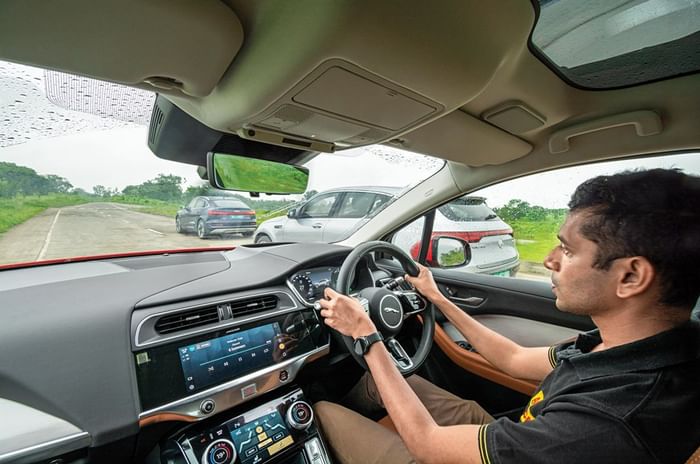
The Jaguar is far better from the driver’s seat than the rear one; it is a hoot to drive.
These are all very refined cars, as you might expect from luxury vehicles without engines, but again, they are not equal. The Audi and Jaguar both inject a bit of artificial noise into the mix, which is a futuristic electric humming sound. It plays outside the car at low speeds to alert pedestrians, and inside the car at all speeds to help give the driver a better sensation of acceleration. The I-Pace can even be made to simulate a rorty sportscar engine, which is quite cool. The EQC, true to the Mercedes ethos, does no such thing and opts for pure silence in the quest for ultimate refinement. You’re also subjected to a bit of road noise in the I-Pace cabin, and relatively speaking, the other two let very little of the outside world in.
Inner Peace
Sticking with the conventions of luxury car buyers, how the interior is packaged and what it packs in are both of utmost importance, and let’s start with back seats; after all, these cars will still likely be chauffeur driven, at least some of the time. The GLC-based EQC looks and feels the most conventional here, but its smaller size is evident the moment you slip into its narrower, more upright back seat. Sufficient on its own, it simply doesn’t offer as much room as the other two. Choosing a lighter shade of upholstery should help too, as this dark theme in our test car can make you feel a bit cooped up in the back.
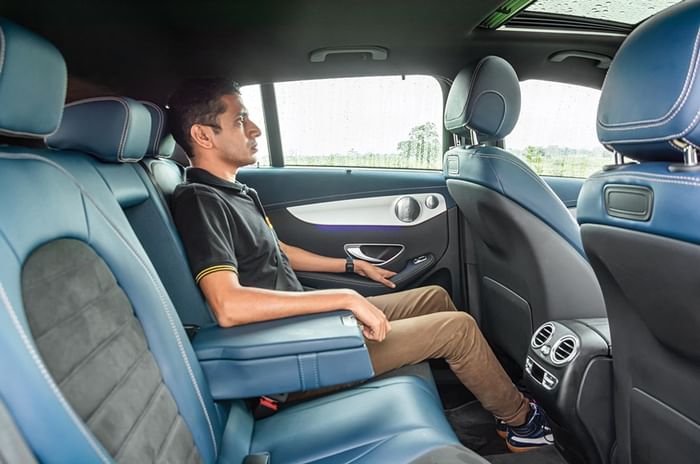
EQC spacious and comfy enough in isolation, but simply feels a class smaller in comparison.
Despite this being the swoopy Sportback version, the Audi e-tron is easily the most spacious car here. The seating position is the most comfortable, legroom is generous and, thanks to a scooped-out headliner there’s more than sufficient headroom too. It also feels the widest and best suited to three, with a seat recline angle that’s just right.
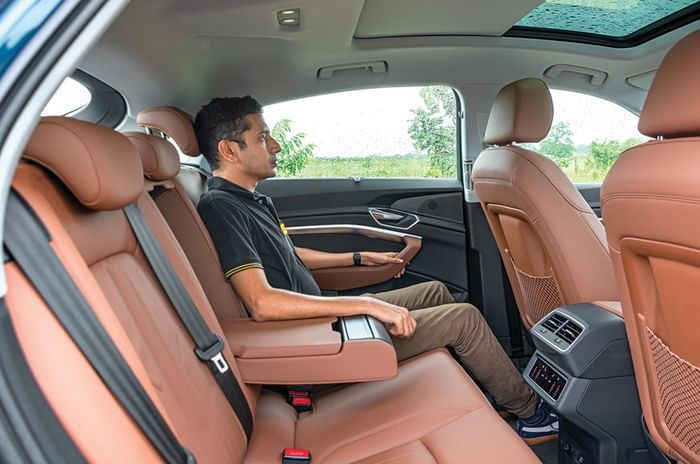
e-tron the most spacious and comfortable, even in this low-roof Sportback guise.
The I-Pace doesn’t look like it would have much interior space at all, but clever packaging has meant the car uses its length, rather than its height, to offer sufficient room for even six-footers in the back. You have to fold yourself under the low roof and through the rear door, and you’ll be sat leaned back with your thighs angled upwards, but once in place, it’s really comfortable. That 4-seat-sportscar feeling is clear here, as you don’t get the theatre-like high seating or view forward, and the seat is contoured for two, but what’s truly a standout feature is the fixed glass roof that extends way back for an incredibly airy feeling.
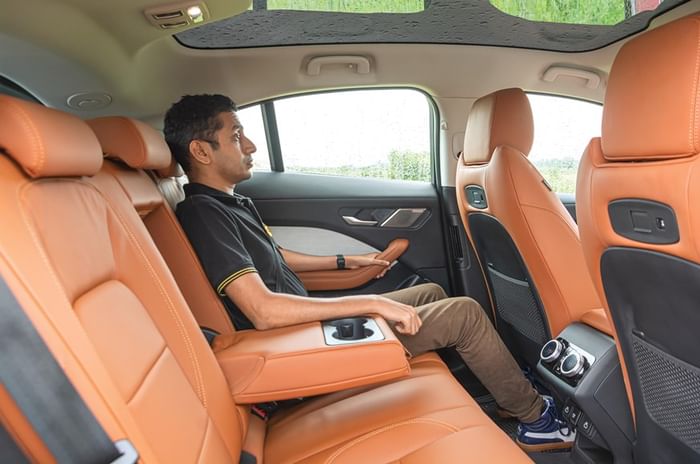
I-Pace has space, but seats you low and at an angle; have to duck through the small doors too.
The thing is, the quality in the Jaguar isn’t quite up there with the Germans and falls just a little short of the sense of richness they impart. There is, however, plenty of wow factor, with a cabin layout and driving position unlike most other cars. The cab-forward design means the A-pillars stretch way down the bonnet, and the driver is sat sportscar low, with a long, floating centre console stretching forward to meet a steeply raked dashboard.
The e-tron’s interior may be a shade flashier than every other Audi, but compared to the I-Pace, it looks pretty straight laced. Quality, of course, is just incredible, and interesting touches include the trigger-like gear selector and the hollowed out centre console.

e-tron’s trigger-like gear selector a super cool touch.
Both, the Jag and Audi use touchscreens for their AC controls, but the I-Pace at least lets you handle basic temperature, blower and seat ventilation control via physical knobs.
Considering that much of the EQC’s interior is lifted straight from the GLC, Mercedes has done a great job of making it feel unique and futuristic with the parts that aren’t. The dashboard top is new, for instance, it’s raked back a lot more and with a swooping band of trim spanning its width. There are bronze accents on the AC vents, pinstriped metallic inlays in the doors, and a nice shelf into which the conjoined 10.25-inch screens sit docked. Quality here, too, is exemplary, but we feel the Audi might just have the edge.
Sure, you probably won’t be doing long-distance road trips in any of these cars, but should you have to do a big airport run, know that the Audi’s 616-litre boot (down from 660 litres of the standard e-tron) is the one that best has you covered. The I-Pace and EQC both offer roughly 500 litres each, and moreover, their spare tyres eat into boot space, while the e-tron has a special cavity to house its space saver.
Being at the cutting edge of technology, and priced accordingly, means none of these brands has skipped on equipment in these cars. What is a bit of a surprise is how many things are optional, and to Mercedes’ credit, despite being the most affordable car here, the EQC does offer a lot in a single, standard spec. The e-tron, too, has some options, but they’re mostly added luxury or tech bits that don’t feel essential. The I-Pace however, despite having three trim levels to choose from, still asks you to add on a lot, some of which – air suspension, four-zone climate control and wireless phone charging, for example – should really have been standard. Its base price may be lower than the Audi’s, but spec it up fully and the Jag could easily become the most expensive.
| Features | |||
|---|---|---|---|
| Audi e-tron Sportback 55 Quattro | Jaguar I-Pace EV400 HSE | Mercedes-Benz EQC 400 | |
| Air suspension | Available | Optional | NA |
| Adaptive dampers | Available | Optional | NA |
| Sunroof | Panoramic | Panoramic fixed glass | Single pane |
| Head-up display | Optional | Optional | Available |
| Digital instruments screen | Available | Available | Available |
| Digital rear-view mirror | NA | Optional | NA |
| Touchscreen | Available | Available | Available |
| Apple CarPlay/Android Auto | Available | Available | Available |
| Powered tailgate | Available | Optional | Available |
| Climate Control | 4-zone | 2-zone/4-zone (Optional) | 3-zone |
| Rear window blinds | Available | NA | Available |
| Wireless phone charging | Available | Optional | Available |
| 360-degree camera | Optional | Available | Available |
| Soft-close doors | Optional | NA | NA |
| Connected Car Tech | NA | Available | Available |
| Adaptive cruise control | NA | Available | NA |
| Airbags | 8 | 6 | 9 |
Power Grid
Keeping the conversation on price, one might argue that the EQC’s Rs 1.07 crore sticker, a full Rs 11 lakh cheaper than the Audi, and which doesn’t ask you to add options, allows it to escape to a segment lower. But frankly, in this corner of the market, that price gap won’t be enough, and the smaller EQC has to be judged against these two. It delivers superbly on luxury, refinement, ride comfort and tech – just as a Mercedes should – but its shortcomings of space and especially range simply cannot be ignored. And yes, there’s the big issue of its precariously low ground clearance too.
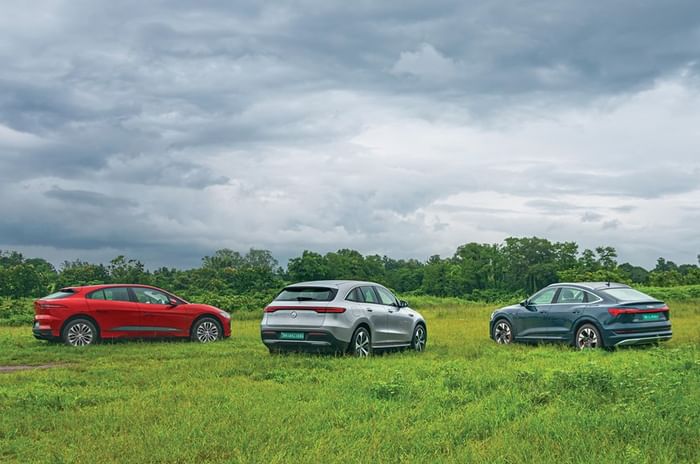
The Jaguar I-Pace is a wonderful collection of contradictions. It’s the quickest and sportiest, but also has the longest range; it’s low and swoopy but has more than enough space inside; and it’s a 2.2-tonne high-riding EV that is as pleasurable to drive as the best sports SUVs out there. For these reasons, it could very well be the luxury EV of choice for many, but it’s not enough to win this test. The steering feels heavy in traffic and, if you don’t option air suspension, the ride can be firm. Then there are the options themselves, a lot of which feel like they should have been standard equipment. But the main reason it loses out is because of the one fundamental thing SUV owners want – space. Both the boot and back seat are disappointingly small and not ideally shaped.
Despite not being as quick or fun or efficient as the I-Pace, you have to admit the e-tron doesn’t fall far behind in any of those areas. That makes it a pretty great EV in its own right, but what seals the deal for the Audi is that it also manages to be the best luxury SUV here. It’s got the best space, comfort, practicality and tech, and the cherry on top is how easy it is to drive and park. If you want even more space, there’s the standard e-tron for Rs 2 lakh less, but we think this Sportback is the best version, adding style without sacrificing practicality. And for now, it’s the best of this new wave of luxury e-SUVs too.
| Verdict | |||
|---|---|---|---|
| Audi e-tron Sportback 55 Quattro | Jaguar I-Pace EV400 HSE | Mercedes-Benz EQC 400 | |
| Price (ex-showroom, India) | Rs 1.18 crore | Rs 1.12 crore | Rs 1.07 crore |
| Rating | 8/10 [OUR CHOICE] | 8/10 | 7/0 |
| Verdict | Superb blend of luxury, comfort, space with electric motoring. | Striking looks meet technical prowess, but lacks practicality. | Refined and comfortable, but feels a class down. |
Copyright (c) Autocar India. All rights reserved.


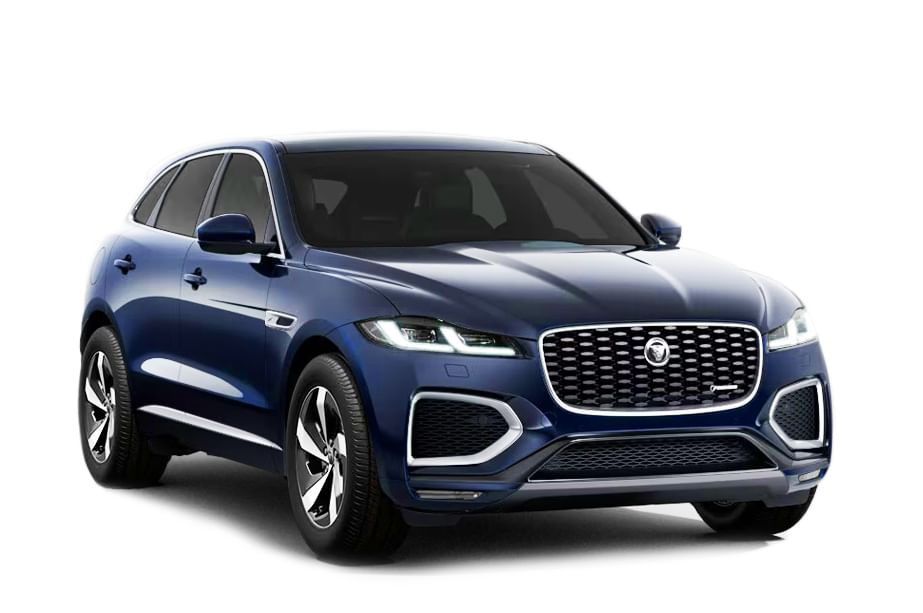


.jpg?w=234&h=156&q=90&c=1)
.jpg?w=234&h=156&q=90&c=1)

Comments
Member Login
Personal Details
No comments yet. Be the first to comment.